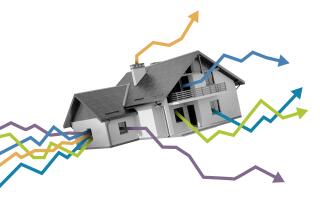Shopping Center Sales Drop 38%
- Share via
Sales of shopping centers dropped by more than 38% in Southern California last year--the second year in a row that the number of sales declined--but selling prices continued to rise.
The combination of fewer sales and higher prices, according to a new report, suggests that most centers are doing well and owners are reluctant to sell unless they get top dollar. Many buyers, meanwhile, are reluctant to pay premium prices.
“Everybody [who wants to buy a center] has been complaining that there’s no inventory for sale, and the reason is there isn’t a lot of pressure for owners to sell,” said George Garvin, author of the report and a Grubb & Ellis broker who specializes in shopping center sales. “Properties are cash-flowing, rents are high and vacancies are low.”
The number of shopping centers sold in six Southern California counties dropped to 1,234 last year from 2,000 in 1999, Garvin said, while the median price per square foot paid for centers rose to $112.83 from $104.59.
The higher prices are a sign that buyers have faith in shopping centers, according to Garvin, who said rising prices indicate that many investors still expect to earn a reasonable return--about 9% to 10% annually.
Nonetheless, the slowdown in sales is a sign that not all buyers are willing to pay the higher prices, Garvin said, adding that he believes higher interest rates last year also slowed sales.
Steve Boss of San Marino, a buyer looking for centers in Southern California, believes sales also slowed because of prospective buyers’ worries about a slowing economy, a fall-off in consumer spending and store closings by several major retailers.
“We took a wait-and-see attitude last year,” said Boss, vice president of West Coast acquisitions for Washington, D.C.-based Combined Properties Inc., which owns about 5 million square feet of centers in Washington and Southern California.
Combined Properties is “still being very cautious” in its buying, but Boss believes sellers this year might be more willing to negotiate on prices than they were last year.
Still, he said, it’s getting tougher to find the kind of deals Combined Properties likes--neighborhood shopping centers that are mismanaged, under-performing or otherwise have potential for a new owner to come in and boost the property’s value.
The current retail real estate climate represents a sharp contrast from the mid-1990s, Boss said, when many more foreclosed and distressed properties were on the market, which was still feeling the effects of the recession.
(BEGIN TEXT OF INFOBOX / INFOGRAPHIC)
Sales of Malls Slump
Sales of shopping centers dropped sharply in Southern California last year after holding steady for the two previous years, but prices paid for the centers have climbed steadily for years.
*
1997
* Number of sales: 1,757
* Dollar volume of sales: $4.7 billion
* Median price per square foot: $88.81
1998
* Number of sales: 2,086
* Dollar volume of sales: $3.9 billion
* Median price per square foot: $98.80
1999
* Number of sales: 2,000
* Dollar volume of sales: $2.8 billion
* Median price per square foot: $104.59
2000
* Number of sales: 1,234
* Dollar volume of sales: $1.7 billion
* Median price per square foot: $112.83 *
Sources: Grubb & Ellis Co., Comps Inc.
More to Read
Inside the business of entertainment
The Wide Shot brings you news, analysis and insights on everything from streaming wars to production — and what it all means for the future.
You may occasionally receive promotional content from the Los Angeles Times.










